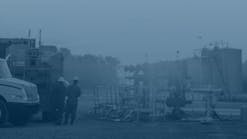HEBRON, BAY DU NORD DISCOVERIES EXPECTED TO ALTER CURRENT PRODUCTION DECLINE
OLGA KERIMOVA AND THEODORA BATOUDAKI, RYSTAD ENERGY
PRODUCTION FROM mature offshore fields in Eastern Canada is declining. However, volumes from large fields coming online after 2017 are expected to offset this trend. In addition to already discovered resources, located mostly in the Jeanne d'Arc and Flemish Pass basins in the Newfoundland and Labrador province, operators such as Statoil, BP, and Shell are actively engaging in exploration in the area, and more operators may follow suit.
Figure 1 shows total historical and forecasted offshore production from the East coast of Canada from 2010 to 2025, split by hydrocarbon. Over the past five years, this region has seen declining production dominated by large oil fields discovered in the 70s and 80s, such as Hibernia (ExxonMobil-operated), Terra Nova (Suncor) and White Rose (Husky Energy). Oil production decrease was especially noticeable in 2012, resulting mainly from shut-in production in the White Rose and Terra Nova fields due to FPSO and other repairs and maintenance. Production is expected to continue its natural decline until at least 2017/2018, when the commissioning of ExxonMobil's Hebron field may reverse this trend. Statoil's Bay du Nord discovery in the Flemish Pass Basin will further contribute to production growth after 2020. Almost all of the volumes in the Newfoundland and Labrador province consist of crude oil and associated gas, which is typically re-injected into the reservoir. On the other hand, most of the resources in Nova Scotia are from gas fields, with Encana's Panuke Deep and ExxonMobil's Alma (Sable Offshore Energy Project) being two of the largest.
Figure 2 shows the discovered volumes in the Newfoundland and Labrador province offshore Canada from 2005 to 2013. Resources of roughly 260 MMboe were added to ExxonMobil's Hibernia, after the discoveries in Hibernia Southern extension and Hibernia South in 2005 and 2008, respectively. Hibernia Southern extension, with first oil production in 2011, is currently in the ramp-up phase, while the main field, Hibernia, with start-up in 1997, is in a natural decline phase. Although White Rose is now in decline, additional resources of about 128 MMboe were discovered in White Rose West in 2008, which will contribute to production mainly post 2020. The most significant discoveries were made in 2013 in Harpoon and Bay du Nord fields. Discovered resources of about 570 MMboe in the Statoil-operated Bay du Nord project will be the driver for the production ramp-up from 2023 and onwards. In fact, Bay du Nord is expected to make up 35% of the 2025 production of Newfoundland and Labrador and Nova Scotia shown in Figure 1.
Figure 3 presents total spending in offshore East Coast Canada over the period 2010-2020. Capex is not expected to increase until 2020 when Statoil and Husky may start developing the Bay du Nord project. The growth in exploration spending over the next four years is explained by increasing exploration activity by existing operators in the area such as Husky, ExxonMobil and Statoil, as well as BP and Shell. Statoil and ExxonMobil are expected to invest in further exploration in the Flemish Pass Basin, while BP and Shell are focusing their exploration efforts in Nova Scotia, where they were awarded several license blocks in 2012/2013. The operating costs (opex) are expected to be at around $1.5 billion per year, accounting for inflation, over the next two years and then increase gradually to $1.8 billion in 2020, consistent with increasing production from 2018.
CONCLUSION
Currently, production is in natural decline, but this trend is expected to be altered by the large Hebron and Bay Du Nord discoveries from 2017 and onwards. Although no new discoveries had been made since Bay du Nord, 2014 was marked by ongoing exploration efforts from several operators. Bay du Nord has revitalized interest in the region (record bid by ExxonMobil in the Flemish Pass Basin in 2014), but some uncertainty remains around the timing of exploration investments in the current oil price environment.
ABOUT THE AUTHORS
Olga Kerimova ([email protected]) is an analyst at Rystad Energy. She analyzes oil and gas data in unconventional oil plays, asset shale modeling, QA and overall data consistency. She holds an M.Sc. in Environmental and Development Economics from the University of Oslo, Norway, and a B.Bus.Sci. (1st class Honors) from the University of Cape Town, South Africa.
Theodora Batoudaki ([email protected]) is an analyst at Rystad Energy. She analyzes unconventional E&P activity in North America, with a focus on shale asset modeling in Permian Midland and the Canadian oil sands. She holds an M.Sc. in Financial Economics from BI Norwegian Business School, Norway and a B.Sc. in Accounting and Finance from Athens University of Economics and Business, Greece.







